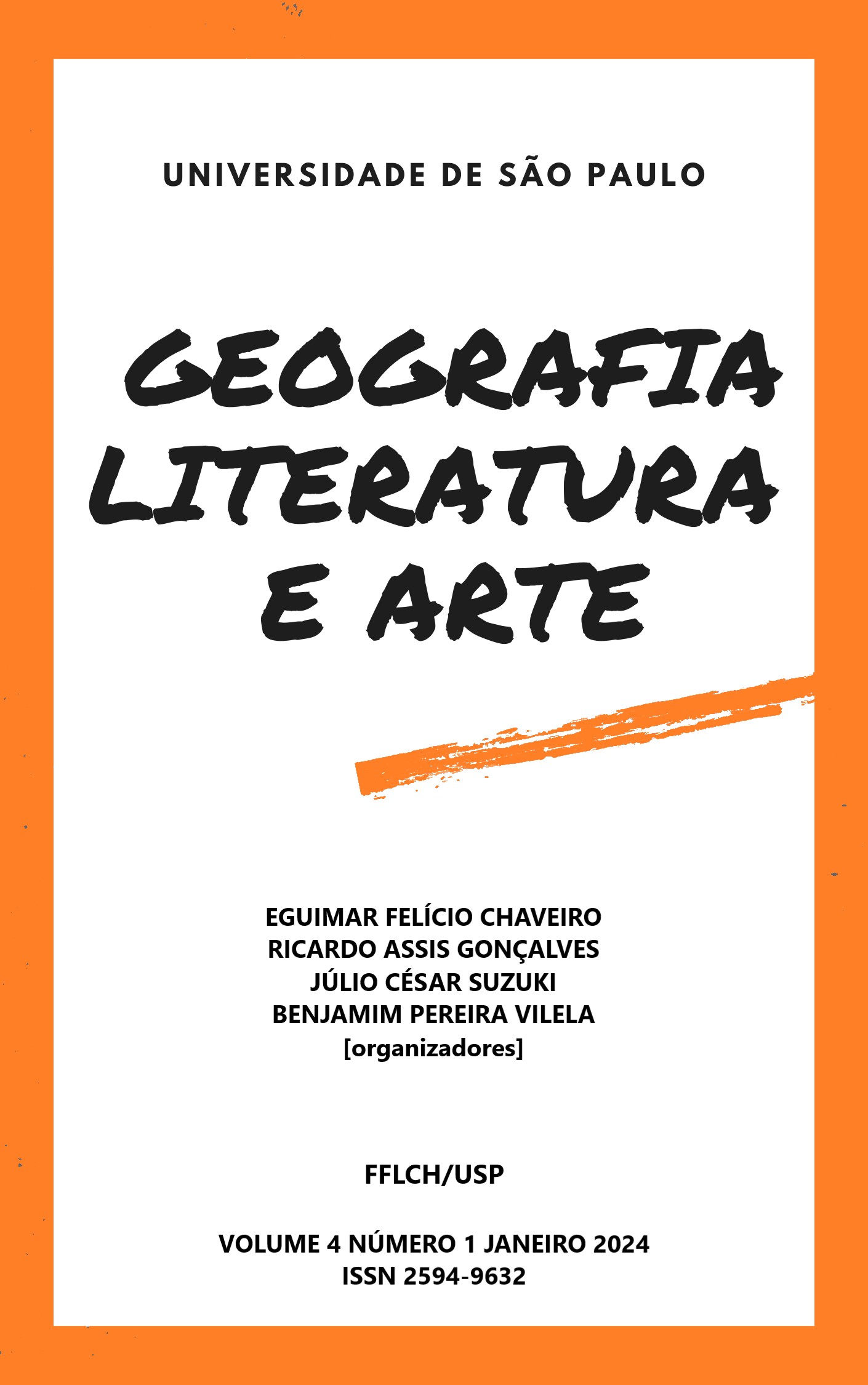THE RAWNESS OF THE CITY WORKER IN ELI BRASILIENSE’S AND CARMO BERNARDES’ NARRATIVES
DOI:
https://doi.org/10.11606/issn.2594-9632.geoliterart.2024.210342Keywords:
Workers, Urban, LiteratureAbstract
Abstract
This article aims to identify the representations of the city workers’ habitus in Eli Brasiliense’s and Carmo Bernardo’s literary works: Chão Vermelho (1956) by Eli Brasiliense and Memórias do Vento (1986) by Carmo Bernardes. Our search seeks to interpret a creative journey and to map its inscribed marks in the history of construction and reproduction of Goiânia City worker’s habitus. Literature, through the Geography perspective, reveals the several possibilities of human emotions and sensibility in a spacial dimension, overflowing the poetic aesthetics of these individuals on the edge of society which are called, by the mentioned authors, as “natural friends”. The stories mentioned keep in them the threads with each worker wowen his daily life, the way each of them reacted to the mistreatment at his work place, suffocating his existance, submerged under unequal power relations and quality of life in Goiânia City in the 50’s and in the 80’s.
Key words: Workers. Urban. Literature.
Downloads
References
ABREU,Marcelo de Paiva.A ordem do progresso:dois séculos de política econômica do Brasil. 2. ed. -Rio de Janeiro: Elsevier, 2014.
ANZALDÚA,Gloria.Borderlands/LaFrontera:TheNewMestiza.SanFrancisco:Aunt Lute Books, 1987.
BERNARDES,Carmo.MemóriasdoVento.SãoPaulo:MarcoZero,1986.BOURDIEU,Pierre.RazõesPráticas:Sobreateoriadaação.3.ed.Campinas:Papirus, 2001a.
BOURDIEU,Pierre.OPoderSimbólico.4.ed.RiodeJaneiro:BertrandBrasil,2001b.BRASILIENSE, Eli. Chão Vermelho.São Paulo: Martins, 1956.
CAMPBELL,Joseph.Oheróidemilfaces.Trad.deAdailUbirajarasobral.SãoPaulo: Pensamento, 2007.
CANDIDO,Antônio.Aliteraturaeaformaçãodohomem.In:Textosdeintervenção.São Paulo: Duas Cidades/Editora 34, 2002.
CENTENO, Yvette (org.) O imaginário da cidade–compilados das comunicações apresentadas no Colóquio sobre o Imaginário da Cidade em Lisboa, 1985. Lisboa: acarte, 1989.
CHAUL,NasrN.Fayad. AconstruçãodeGoiâniaeatransferênciadacapital.Goiânia: UFG, Centro Editorial e Gráfico, 1988.
CHAVES,ElzaGuedes. Deinvasoraposseiro:estado-igrejaealutapela terraurbana.1985. Dissertação(MestradoemAntropologia)UniversidadeFederaldaParaíba,JoãoPessoa,1985.
DESLANDES, Suely Ferreira et al. Pesquisa social:teoria, método e criatividade. OrganizaçãodeMariaCecíliadeSouzaMinayo.34.ed.Petrópolis,RJ:Vozes,2015.
ELIS,Bernardo.Apenas umviolão.RiodeJaneiro:NovaFronteira,1984.
ENGELS, Friedrich. A situação da classe trabalhadora na Inglaterra:Segundo as observaçõesdoautorefontesautênticas.Trad.B.A.Schumann.SãoPaulo:Boitempo,2010.
LEANDRO, Marcus Rossiny. Goiânia:o Chão vermelho em que todos pisam –(manuscrito): História da cidade por meio de Eli Basiliense e Helio de Oliveira, 2016. CCIV, 204 f.:il.
LIMA, Angelita Pereira de. Romancidade:sujeito e existência em leituras geográfico-literárias –os romances A centopeia de neón e Os cordeiros do abismo. 2013. Tese (Doutorado) –Universidade Federal de Goiás, Goiânia, 2013.
MARX,Karl.;ENGELS,Friedrich.TheGermanIdeology.NewYork,International Publishers, 1947.
OLIVIERA,AlírioAfonso.Carrodebois.Diáriodamanhã.Goiânia,p.24,16mai.2009.
OLIVEIRA, Hélio. Eu vi Goiânia crescer:décadas de 50 e 60. Goiânia: Ed. Do Autor, 2008.
PIMENTA, Alberto. A Cidade N.O imaginário da cidade: compilados das comunicações apresentadas no Colóquio sobre o Imaginário da Cidade em Lisboa, 1985. Lisboa: acarte, 1989.
SANTOS,Milton. A Natureza do Espaço: Técnica e Tempo, Razão e Emoção. 4.ed. São Paulo: Editora da Universidade de São Paulo, 2020.
VARGAS LLOSA, Mario. A verdade das mentiras.São Paulo: Arx, 2004
Downloads
Published
Issue
Section
License
Copyright (c) 2024 Sueli Alves de Sousa, Donizette Soares da Silva

This work is licensed under a Creative Commons Attribution 4.0 International License.


